Sydney's Tourism and Hospitality Attractions
VerifiedAdded on 2020/02/24
|5
|1450
|109
AI Summary
This assignment delves into the diverse tourism offerings of Sydney, Australia. It examines popular attractions such as the Sydney Opera House, Harbour Bridge, Circular Quay, Darling Harbour, and The Rocks, highlighting their historical significance, cultural impact, and entertainment value. The document provides a comprehensive overview of Sydney's vibrant hospitality scene, catering to tourists from all walks of life.
Contribute Materials
Your contribution can guide someone’s learning journey. Share your
documents today.
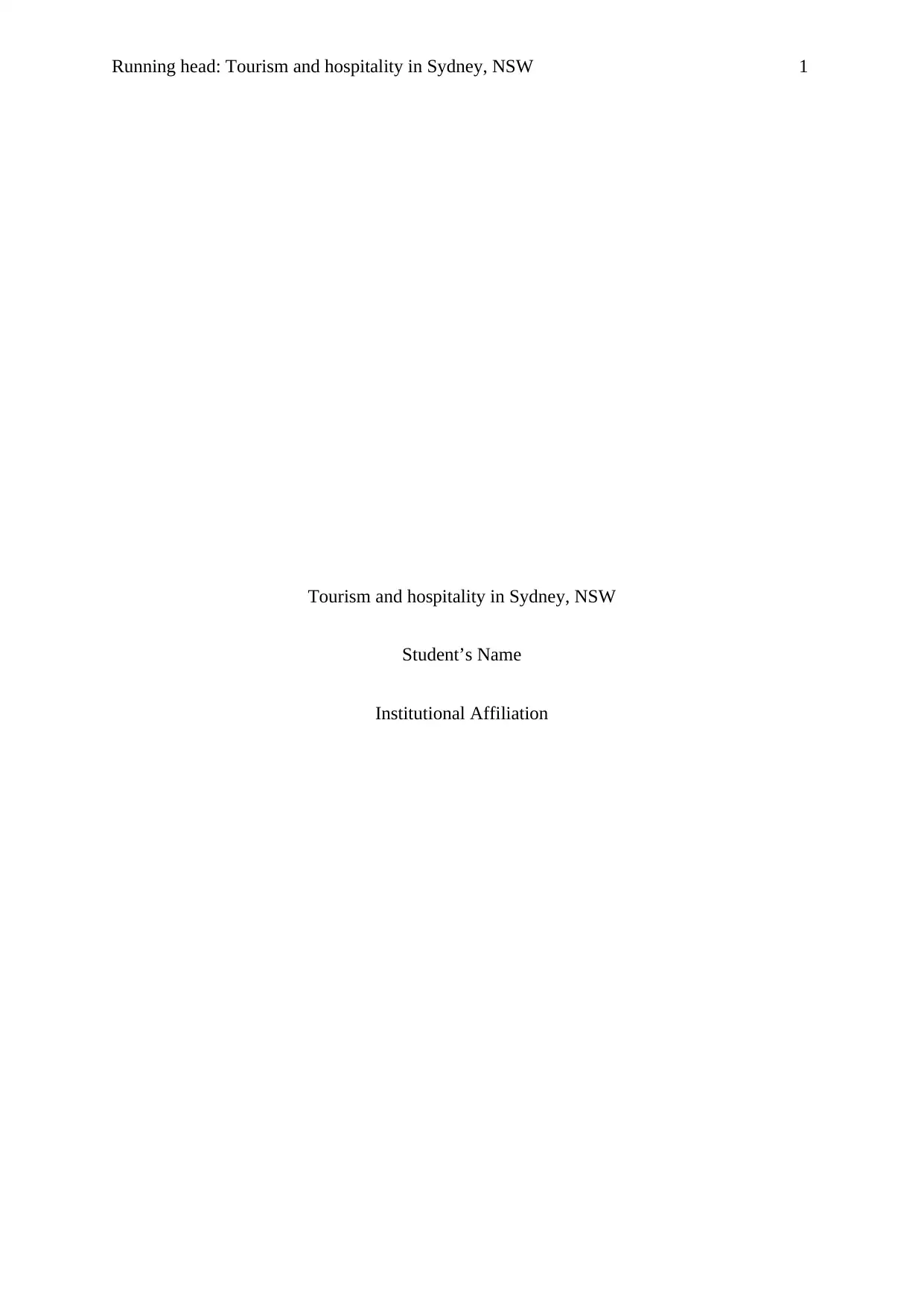
Running head: Tourism and hospitality in Sydney, NSW 1
Tourism and hospitality in Sydney, NSW
Student’s Name
Institutional Affiliation
Tourism and hospitality in Sydney, NSW
Student’s Name
Institutional Affiliation
Secure Best Marks with AI Grader
Need help grading? Try our AI Grader for instant feedback on your assignments.
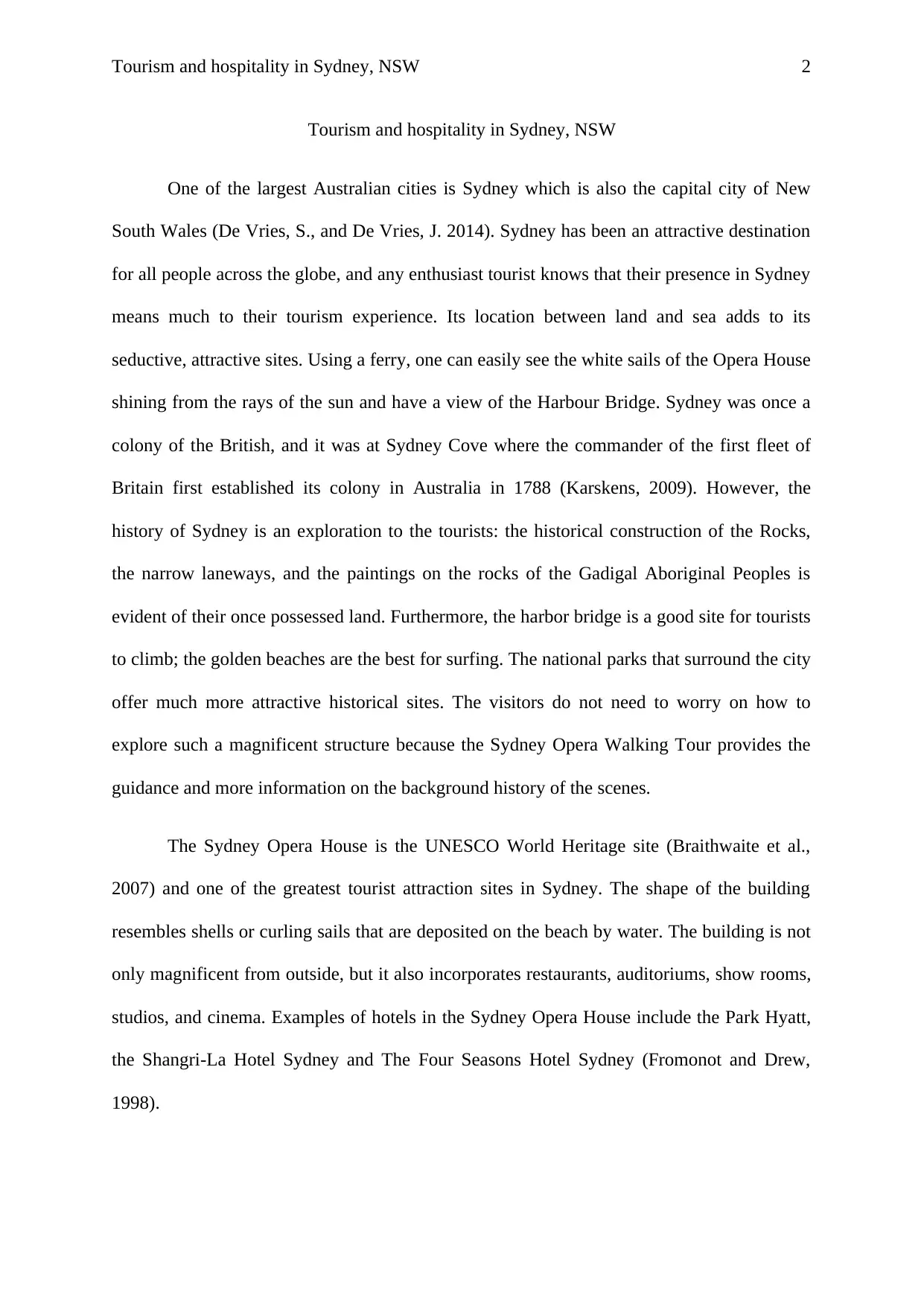
Tourism and hospitality in Sydney, NSW 2
Tourism and hospitality in Sydney, NSW
One of the largest Australian cities is Sydney which is also the capital city of New
South Wales (De Vries, S., and De Vries, J. 2014). Sydney has been an attractive destination
for all people across the globe, and any enthusiast tourist knows that their presence in Sydney
means much to their tourism experience. Its location between land and sea adds to its
seductive, attractive sites. Using a ferry, one can easily see the white sails of the Opera House
shining from the rays of the sun and have a view of the Harbour Bridge. Sydney was once a
colony of the British, and it was at Sydney Cove where the commander of the first fleet of
Britain first established its colony in Australia in 1788 (Karskens, 2009). However, the
history of Sydney is an exploration to the tourists: the historical construction of the Rocks,
the narrow laneways, and the paintings on the rocks of the Gadigal Aboriginal Peoples is
evident of their once possessed land. Furthermore, the harbor bridge is a good site for tourists
to climb; the golden beaches are the best for surfing. The national parks that surround the city
offer much more attractive historical sites. The visitors do not need to worry on how to
explore such a magnificent structure because the Sydney Opera Walking Tour provides the
guidance and more information on the background history of the scenes.
The Sydney Opera House is the UNESCO World Heritage site (Braithwaite et al.,
2007) and one of the greatest tourist attraction sites in Sydney. The shape of the building
resembles shells or curling sails that are deposited on the beach by water. The building is not
only magnificent from outside, but it also incorporates restaurants, auditoriums, show rooms,
studios, and cinema. Examples of hotels in the Sydney Opera House include the Park Hyatt,
the Shangri-La Hotel Sydney and The Four Seasons Hotel Sydney (Fromonot and Drew,
1998).
Tourism and hospitality in Sydney, NSW
One of the largest Australian cities is Sydney which is also the capital city of New
South Wales (De Vries, S., and De Vries, J. 2014). Sydney has been an attractive destination
for all people across the globe, and any enthusiast tourist knows that their presence in Sydney
means much to their tourism experience. Its location between land and sea adds to its
seductive, attractive sites. Using a ferry, one can easily see the white sails of the Opera House
shining from the rays of the sun and have a view of the Harbour Bridge. Sydney was once a
colony of the British, and it was at Sydney Cove where the commander of the first fleet of
Britain first established its colony in Australia in 1788 (Karskens, 2009). However, the
history of Sydney is an exploration to the tourists: the historical construction of the Rocks,
the narrow laneways, and the paintings on the rocks of the Gadigal Aboriginal Peoples is
evident of their once possessed land. Furthermore, the harbor bridge is a good site for tourists
to climb; the golden beaches are the best for surfing. The national parks that surround the city
offer much more attractive historical sites. The visitors do not need to worry on how to
explore such a magnificent structure because the Sydney Opera Walking Tour provides the
guidance and more information on the background history of the scenes.
The Sydney Opera House is the UNESCO World Heritage site (Braithwaite et al.,
2007) and one of the greatest tourist attraction sites in Sydney. The shape of the building
resembles shells or curling sails that are deposited on the beach by water. The building is not
only magnificent from outside, but it also incorporates restaurants, auditoriums, show rooms,
studios, and cinema. Examples of hotels in the Sydney Opera House include the Park Hyatt,
the Shangri-La Hotel Sydney and The Four Seasons Hotel Sydney (Fromonot and Drew,
1998).
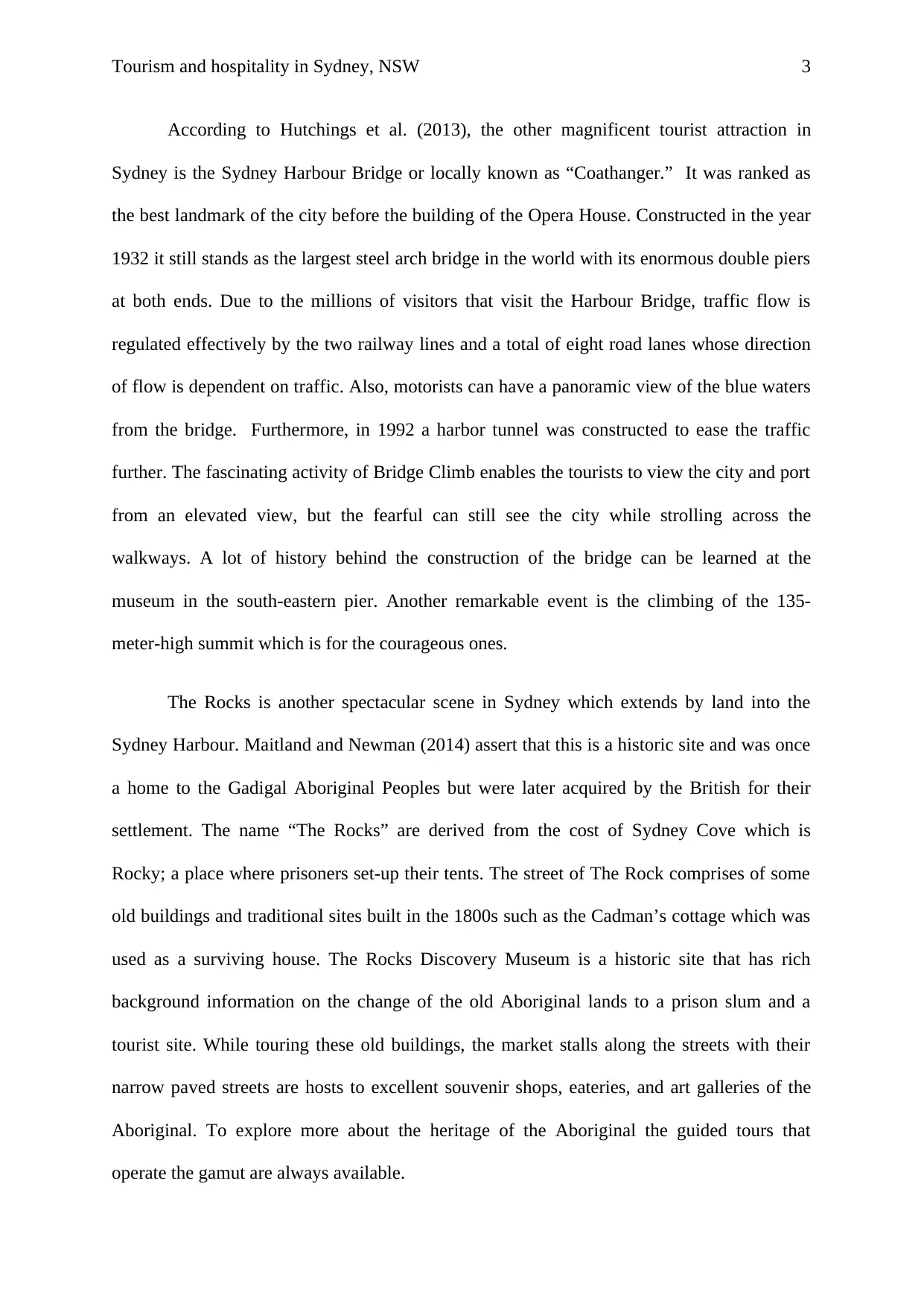
Tourism and hospitality in Sydney, NSW 3
According to Hutchings et al. (2013), the other magnificent tourist attraction in
Sydney is the Sydney Harbour Bridge or locally known as “Coathanger.” It was ranked as
the best landmark of the city before the building of the Opera House. Constructed in the year
1932 it still stands as the largest steel arch bridge in the world with its enormous double piers
at both ends. Due to the millions of visitors that visit the Harbour Bridge, traffic flow is
regulated effectively by the two railway lines and a total of eight road lanes whose direction
of flow is dependent on traffic. Also, motorists can have a panoramic view of the blue waters
from the bridge. Furthermore, in 1992 a harbor tunnel was constructed to ease the traffic
further. The fascinating activity of Bridge Climb enables the tourists to view the city and port
from an elevated view, but the fearful can still see the city while strolling across the
walkways. A lot of history behind the construction of the bridge can be learned at the
museum in the south-eastern pier. Another remarkable event is the climbing of the 135-
meter-high summit which is for the courageous ones.
The Rocks is another spectacular scene in Sydney which extends by land into the
Sydney Harbour. Maitland and Newman (2014) assert that this is a historic site and was once
a home to the Gadigal Aboriginal Peoples but were later acquired by the British for their
settlement. The name “The Rocks” are derived from the cost of Sydney Cove which is
Rocky; a place where prisoners set-up their tents. The street of The Rock comprises of some
old buildings and traditional sites built in the 1800s such as the Cadman’s cottage which was
used as a surviving house. The Rocks Discovery Museum is a historic site that has rich
background information on the change of the old Aboriginal lands to a prison slum and a
tourist site. While touring these old buildings, the market stalls along the streets with their
narrow paved streets are hosts to excellent souvenir shops, eateries, and art galleries of the
Aboriginal. To explore more about the heritage of the Aboriginal the guided tours that
operate the gamut are always available.
According to Hutchings et al. (2013), the other magnificent tourist attraction in
Sydney is the Sydney Harbour Bridge or locally known as “Coathanger.” It was ranked as
the best landmark of the city before the building of the Opera House. Constructed in the year
1932 it still stands as the largest steel arch bridge in the world with its enormous double piers
at both ends. Due to the millions of visitors that visit the Harbour Bridge, traffic flow is
regulated effectively by the two railway lines and a total of eight road lanes whose direction
of flow is dependent on traffic. Also, motorists can have a panoramic view of the blue waters
from the bridge. Furthermore, in 1992 a harbor tunnel was constructed to ease the traffic
further. The fascinating activity of Bridge Climb enables the tourists to view the city and port
from an elevated view, but the fearful can still see the city while strolling across the
walkways. A lot of history behind the construction of the bridge can be learned at the
museum in the south-eastern pier. Another remarkable event is the climbing of the 135-
meter-high summit which is for the courageous ones.
The Rocks is another spectacular scene in Sydney which extends by land into the
Sydney Harbour. Maitland and Newman (2014) assert that this is a historic site and was once
a home to the Gadigal Aboriginal Peoples but were later acquired by the British for their
settlement. The name “The Rocks” are derived from the cost of Sydney Cove which is
Rocky; a place where prisoners set-up their tents. The street of The Rock comprises of some
old buildings and traditional sites built in the 1800s such as the Cadman’s cottage which was
used as a surviving house. The Rocks Discovery Museum is a historic site that has rich
background information on the change of the old Aboriginal lands to a prison slum and a
tourist site. While touring these old buildings, the market stalls along the streets with their
narrow paved streets are hosts to excellent souvenir shops, eateries, and art galleries of the
Aboriginal. To explore more about the heritage of the Aboriginal the guided tours that
operate the gamut are always available.
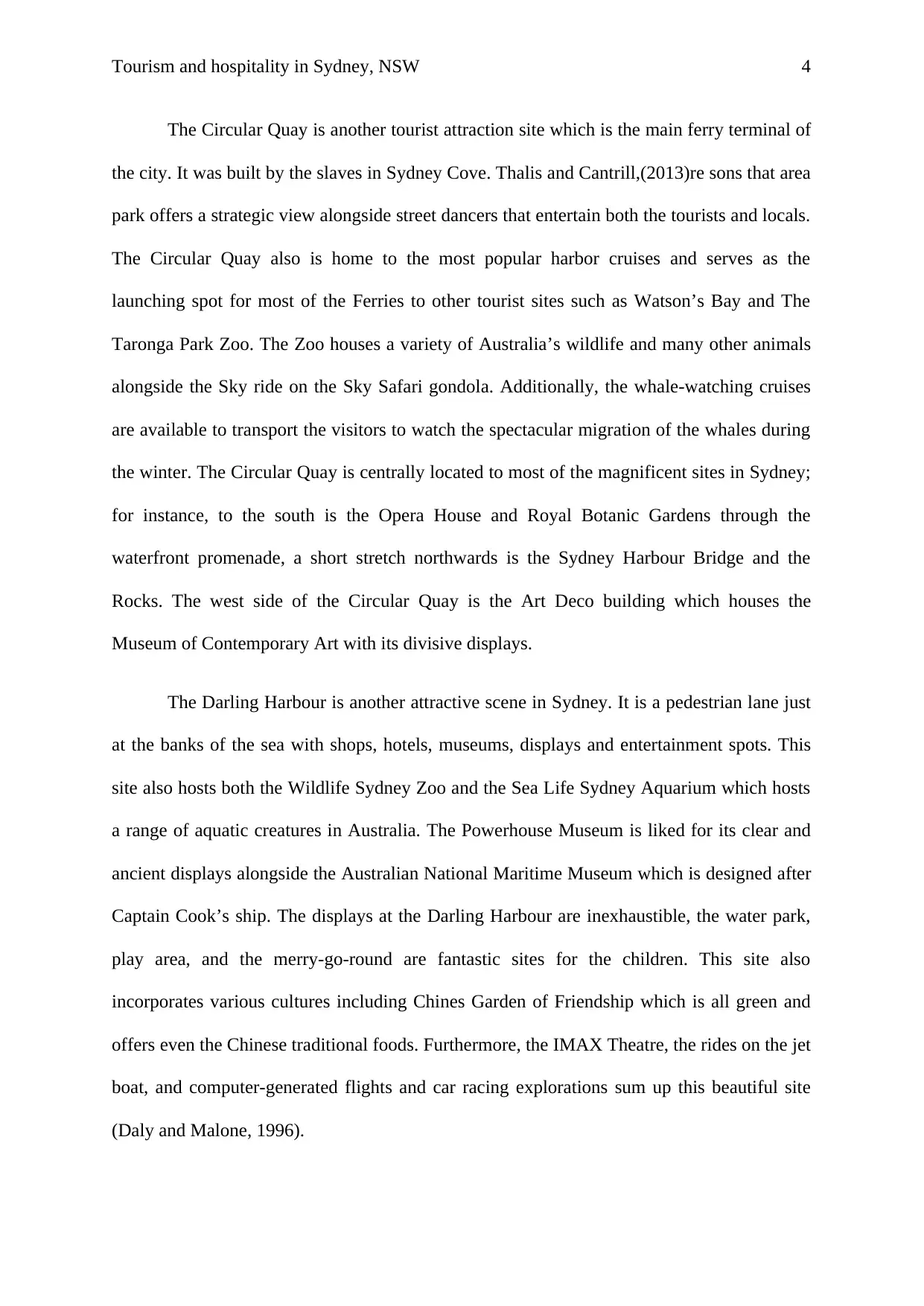
Tourism and hospitality in Sydney, NSW 4
The Circular Quay is another tourist attraction site which is the main ferry terminal of
the city. It was built by the slaves in Sydney Cove. Thalis and Cantrill,(2013)re sons that area
park offers a strategic view alongside street dancers that entertain both the tourists and locals.
The Circular Quay also is home to the most popular harbor cruises and serves as the
launching spot for most of the Ferries to other tourist sites such as Watson’s Bay and The
Taronga Park Zoo. The Zoo houses a variety of Australia’s wildlife and many other animals
alongside the Sky ride on the Sky Safari gondola. Additionally, the whale-watching cruises
are available to transport the visitors to watch the spectacular migration of the whales during
the winter. The Circular Quay is centrally located to most of the magnificent sites in Sydney;
for instance, to the south is the Opera House and Royal Botanic Gardens through the
waterfront promenade, a short stretch northwards is the Sydney Harbour Bridge and the
Rocks. The west side of the Circular Quay is the Art Deco building which houses the
Museum of Contemporary Art with its divisive displays.
The Darling Harbour is another attractive scene in Sydney. It is a pedestrian lane just
at the banks of the sea with shops, hotels, museums, displays and entertainment spots. This
site also hosts both the Wildlife Sydney Zoo and the Sea Life Sydney Aquarium which hosts
a range of aquatic creatures in Australia. The Powerhouse Museum is liked for its clear and
ancient displays alongside the Australian National Maritime Museum which is designed after
Captain Cook’s ship. The displays at the Darling Harbour are inexhaustible, the water park,
play area, and the merry-go-round are fantastic sites for the children. This site also
incorporates various cultures including Chines Garden of Friendship which is all green and
offers even the Chinese traditional foods. Furthermore, the IMAX Theatre, the rides on the jet
boat, and computer-generated flights and car racing explorations sum up this beautiful site
(Daly and Malone, 1996).
The Circular Quay is another tourist attraction site which is the main ferry terminal of
the city. It was built by the slaves in Sydney Cove. Thalis and Cantrill,(2013)re sons that area
park offers a strategic view alongside street dancers that entertain both the tourists and locals.
The Circular Quay also is home to the most popular harbor cruises and serves as the
launching spot for most of the Ferries to other tourist sites such as Watson’s Bay and The
Taronga Park Zoo. The Zoo houses a variety of Australia’s wildlife and many other animals
alongside the Sky ride on the Sky Safari gondola. Additionally, the whale-watching cruises
are available to transport the visitors to watch the spectacular migration of the whales during
the winter. The Circular Quay is centrally located to most of the magnificent sites in Sydney;
for instance, to the south is the Opera House and Royal Botanic Gardens through the
waterfront promenade, a short stretch northwards is the Sydney Harbour Bridge and the
Rocks. The west side of the Circular Quay is the Art Deco building which houses the
Museum of Contemporary Art with its divisive displays.
The Darling Harbour is another attractive scene in Sydney. It is a pedestrian lane just
at the banks of the sea with shops, hotels, museums, displays and entertainment spots. This
site also hosts both the Wildlife Sydney Zoo and the Sea Life Sydney Aquarium which hosts
a range of aquatic creatures in Australia. The Powerhouse Museum is liked for its clear and
ancient displays alongside the Australian National Maritime Museum which is designed after
Captain Cook’s ship. The displays at the Darling Harbour are inexhaustible, the water park,
play area, and the merry-go-round are fantastic sites for the children. This site also
incorporates various cultures including Chines Garden of Friendship which is all green and
offers even the Chinese traditional foods. Furthermore, the IMAX Theatre, the rides on the jet
boat, and computer-generated flights and car racing explorations sum up this beautiful site
(Daly and Malone, 1996).
Secure Best Marks with AI Grader
Need help grading? Try our AI Grader for instant feedback on your assignments.
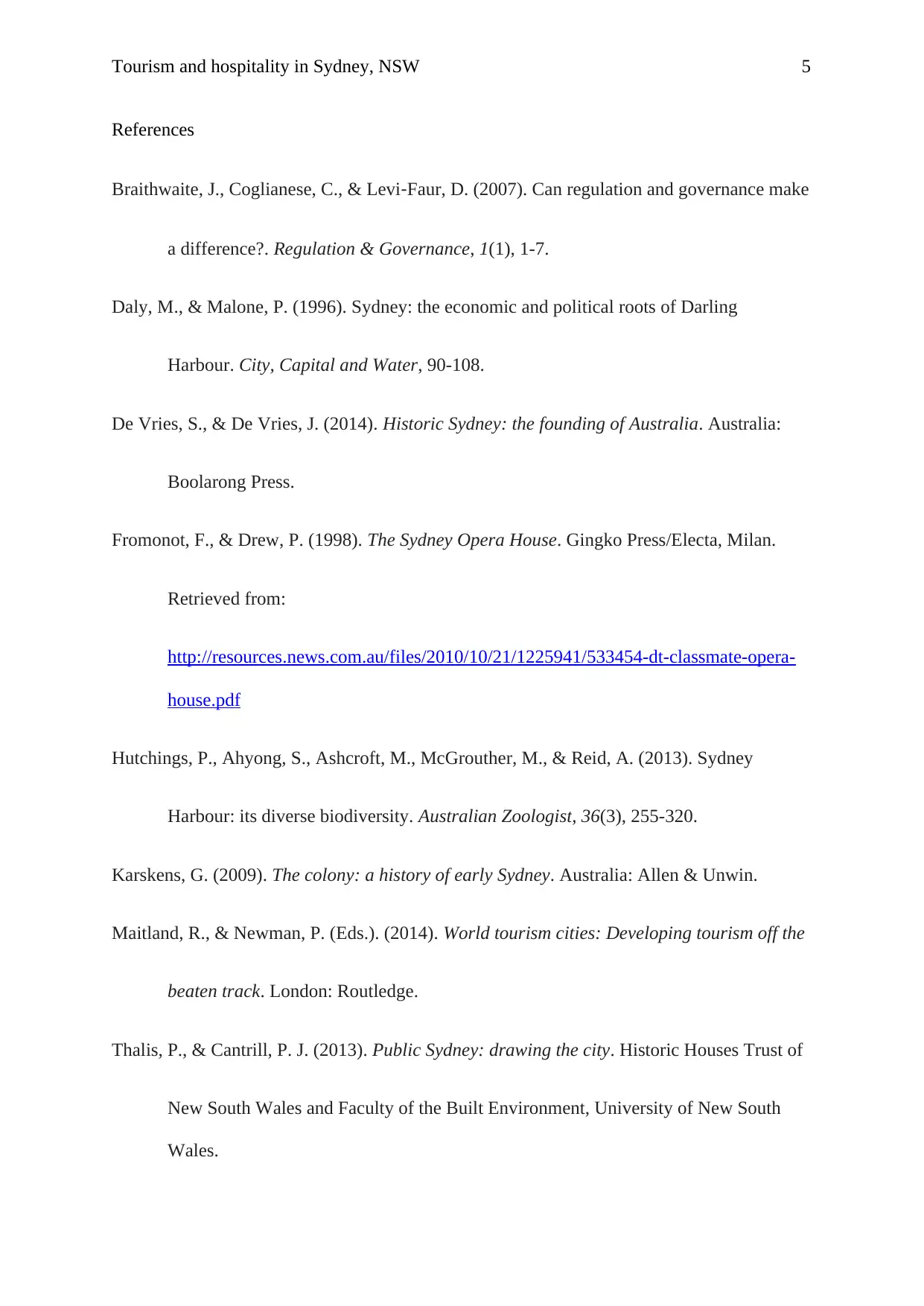
Tourism and hospitality in Sydney, NSW 5
References
Braithwaite, J., Coglianese, C., & Levi‐Faur, D. (2007). Can regulation and governance make
a difference?. Regulation & Governance, 1(1), 1-7.
Daly, M., & Malone, P. (1996). Sydney: the economic and political roots of Darling
Harbour. City, Capital and Water, 90-108.
De Vries, S., & De Vries, J. (2014). Historic Sydney: the founding of Australia. Australia:
Boolarong Press.
Fromonot, F., & Drew, P. (1998). The Sydney Opera House. Gingko Press/Electa, Milan.
Retrieved from:
http://resources.news.com.au/files/2010/10/21/1225941/533454-dt-classmate-opera-
house.pdf
Hutchings, P., Ahyong, S., Ashcroft, M., McGrouther, M., & Reid, A. (2013). Sydney
Harbour: its diverse biodiversity. Australian Zoologist, 36(3), 255-320.
Karskens, G. (2009). The colony: a history of early Sydney. Australia: Allen & Unwin.
Maitland, R., & Newman, P. (Eds.). (2014). World tourism cities: Developing tourism off the
beaten track. London: Routledge.
Thalis, P., & Cantrill, P. J. (2013). Public Sydney: drawing the city. Historic Houses Trust of
New South Wales and Faculty of the Built Environment, University of New South
Wales.
References
Braithwaite, J., Coglianese, C., & Levi‐Faur, D. (2007). Can regulation and governance make
a difference?. Regulation & Governance, 1(1), 1-7.
Daly, M., & Malone, P. (1996). Sydney: the economic and political roots of Darling
Harbour. City, Capital and Water, 90-108.
De Vries, S., & De Vries, J. (2014). Historic Sydney: the founding of Australia. Australia:
Boolarong Press.
Fromonot, F., & Drew, P. (1998). The Sydney Opera House. Gingko Press/Electa, Milan.
Retrieved from:
http://resources.news.com.au/files/2010/10/21/1225941/533454-dt-classmate-opera-
house.pdf
Hutchings, P., Ahyong, S., Ashcroft, M., McGrouther, M., & Reid, A. (2013). Sydney
Harbour: its diverse biodiversity. Australian Zoologist, 36(3), 255-320.
Karskens, G. (2009). The colony: a history of early Sydney. Australia: Allen & Unwin.
Maitland, R., & Newman, P. (Eds.). (2014). World tourism cities: Developing tourism off the
beaten track. London: Routledge.
Thalis, P., & Cantrill, P. J. (2013). Public Sydney: drawing the city. Historic Houses Trust of
New South Wales and Faculty of the Built Environment, University of New South
Wales.
1 out of 5
Related Documents
Your All-in-One AI-Powered Toolkit for Academic Success.
+13062052269
info@desklib.com
Available 24*7 on WhatsApp / Email
![[object Object]](/_next/static/media/star-bottom.7253800d.svg)
Unlock your academic potential
© 2024 | Zucol Services PVT LTD | All rights reserved.





